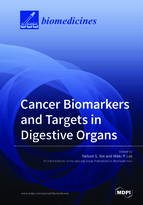Cancer Biomarkers and Targets in Digestive Organs
A special issue of Biomedicines (ISSN 2227-9059). This special issue belongs to the section "Cancer Biology and Oncology".
Deadline for manuscript submissions: closed (30 April 2018) | Viewed by 56597
Special Issue Editors
Interests: cancer biomarkers, cancer therapy, clinical investigation, machine learning, translational research
Special Issues, Collections and Topics in MDPI journals
Special Issue Information
Dear Colleagues,
Identification and development of cancer biomarkers and targets have greatly accelerated progress towards precision medicine in oncology. Studies of tumor biology have not only provided insights into the mechanisms underlying carcinogenesis, but also led to discovery of molecules that have been developed into cancer biomarkers and targets. Multi-platforms for molecular characterization of tumors using next-generation genomic sequencing, immunohistochemistry, in situ hybridization, and blood-based biopsies have greatly expanded the portfolio of potential biomarkers and targets. These cancer biomarkers have been developed for diagnosis, early detection, prognosis, and prediction of treatment response. The molecular targets have been exploited for anti-cancer therapy and delivery of therapeutic agents. This Special Issue of Biomedicines focuses on recent advances in the discovery, characterization, translation, and clinical application of cancer biomarkers and targets in malignant diseases of the digestive system. The goal is to stimulate research and clinical interests in this exciting field with the hope of developing strategies for prevention and early detection of cancers in digestive organs, and improving treatment outcomes in patients with these malignant diseases.
Dr. Nelson Yee
Dr. Nikki Lee
Guest Editor
Manuscript Submission Information
Manuscripts should be submitted online at www.mdpi.com by registering and logging in to this website. Once you are registered, click here to go to the submission form. Manuscripts can be submitted until the deadline. All submissions that pass pre-check are peer-reviewed. Accepted papers will be published continuously in the journal (as soon as accepted) and will be listed together on the special issue website. Research articles, review articles as well as short communications are invited. For planned papers, a title and short abstract (about 100 words) can be sent to the Editorial Office for announcement on this website.
Submitted manuscripts should not have been published previously, nor be under consideration for publication elsewhere (except conference proceedings papers). All manuscripts are thoroughly refereed through a single-blind peer-review process. A guide for authors and other relevant information for submission of manuscripts is available on the Instructions for Authors page. Biomedicines is an international peer-reviewed open access monthly journal published by MDPI.
Please visit the Instructions for Authors page before submitting a manuscript. The Article Processing Charge (APC) for publication in this open access journal is 2600 CHF (Swiss Francs). Submitted papers should be well formatted and use good English. Authors may use MDPI's English editing service prior to publication or during author revisions.
Keywords
- gastrointestinal oncology
- biomarkers
- targets
- circulating tumor cells
- extracellular vesicles
- molecular profiling
- precision medicine








